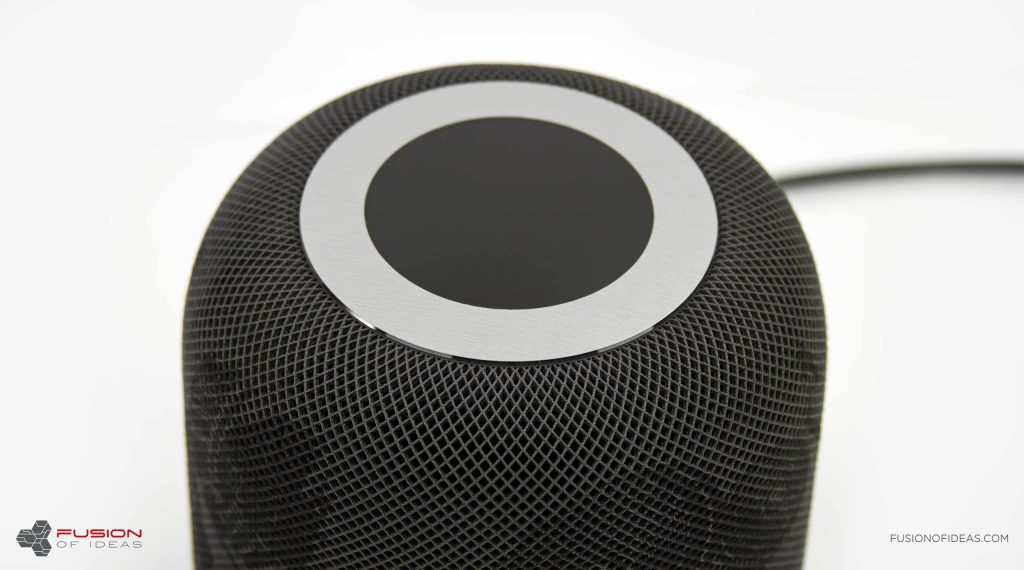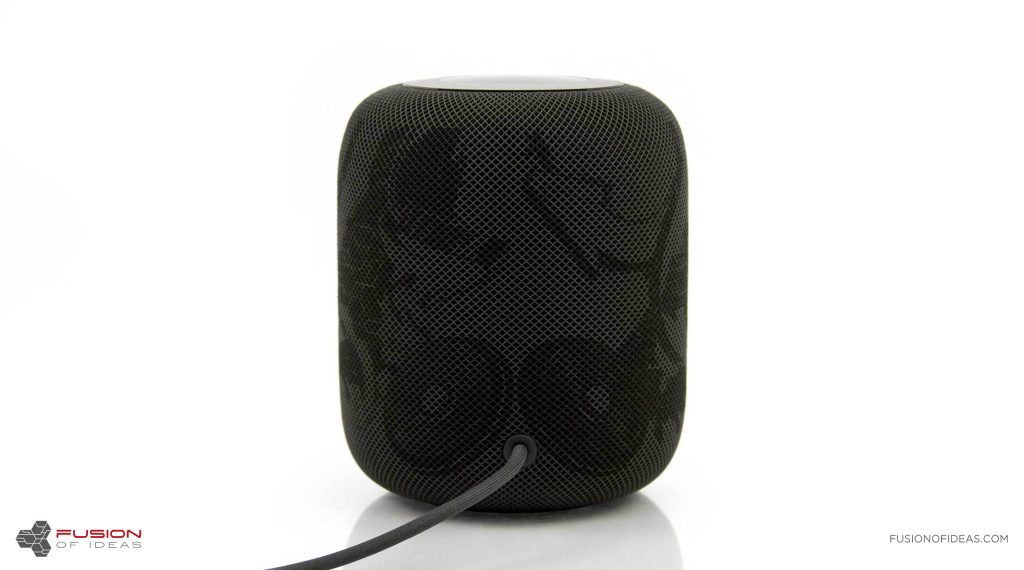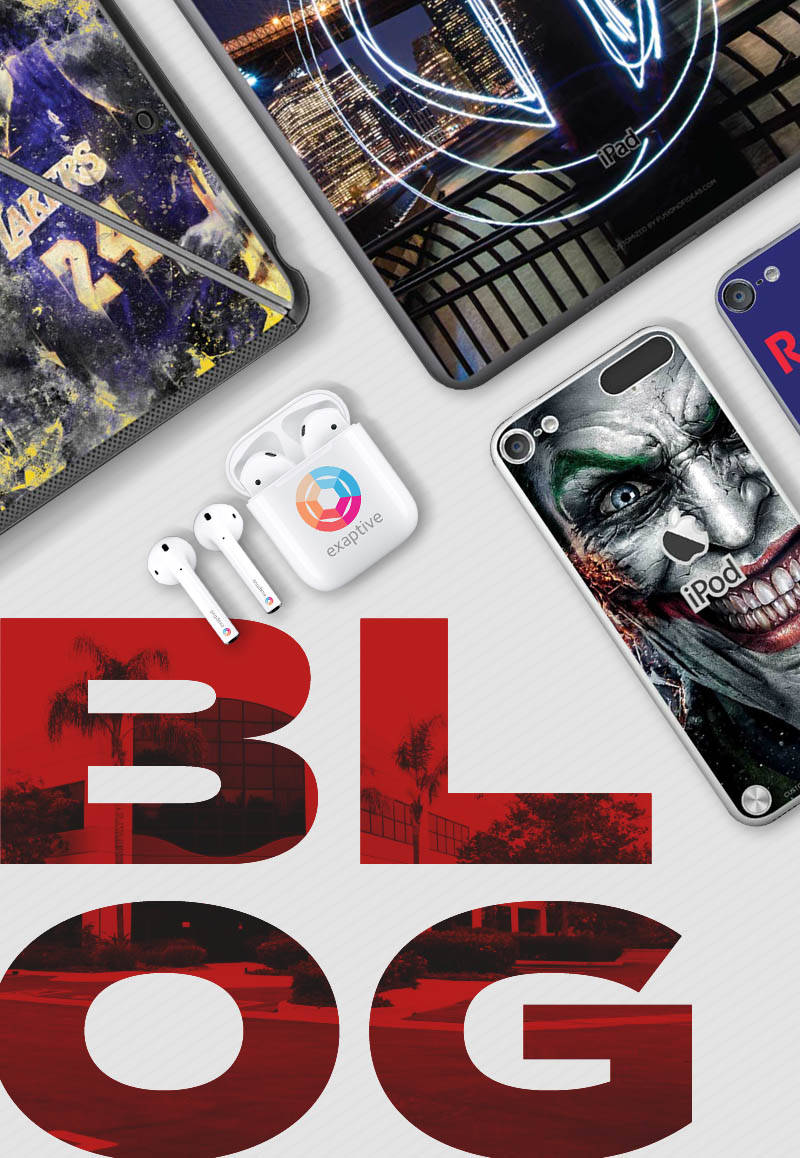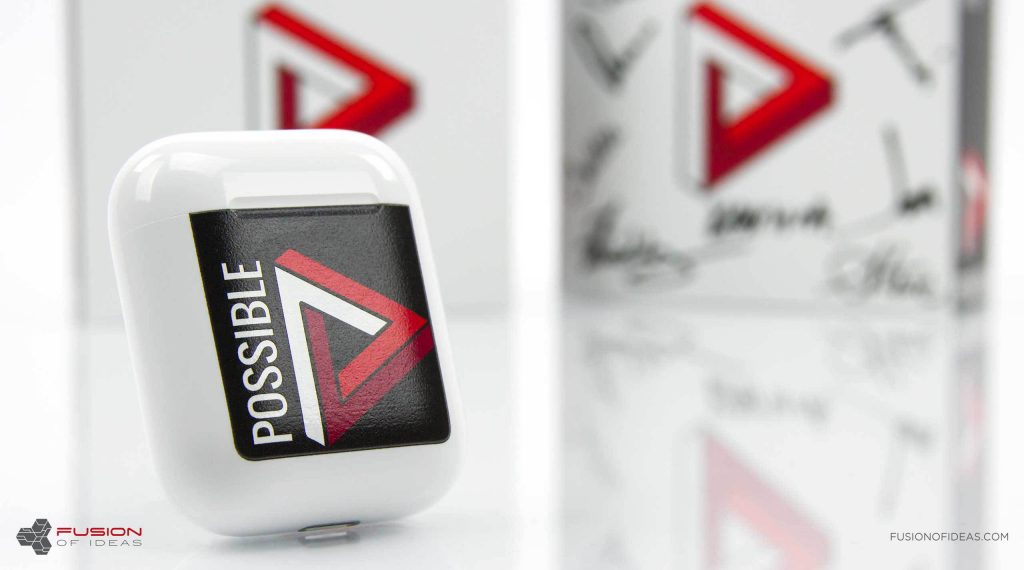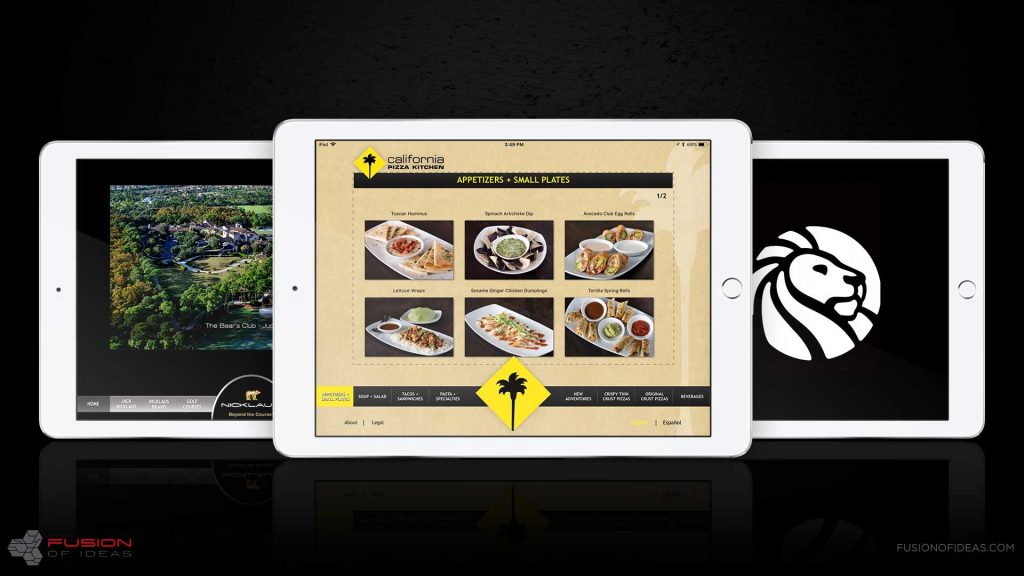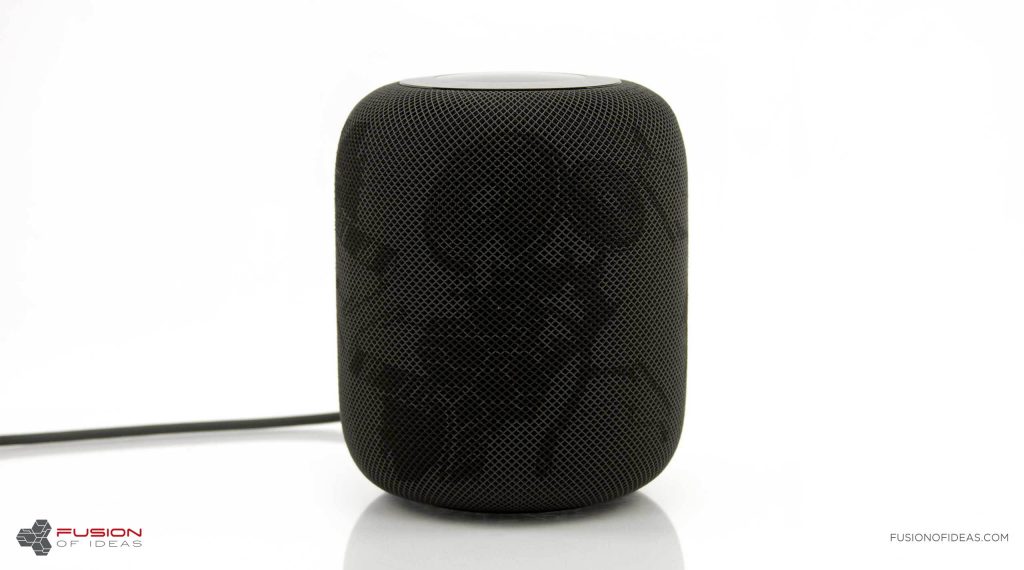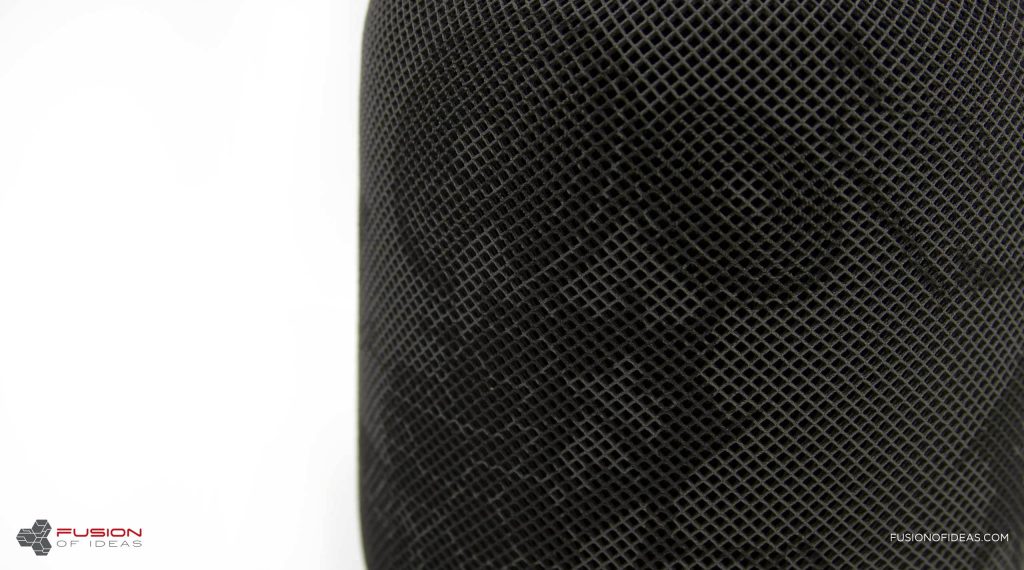We’re predicting that the Apple HomePod might be at the top of many gift lists for the holiday season later this year. The HomePod already gets major cool points as a gift, but when you add laser engraving, custom printing, custom packaging, and custom gift wrap, you take it to a whole new level. Our Business Development Team made a very cool video to show how you can customize a HomePod. Check it out!
Xilinx AirPod Project
 It was almost exactly a year ago that the Xilinx project went down in Fusion of Ideas history. The new Apple AirPods had just been announced, and everyone was anxiously waiting for them to hit the market. A few months had gone by since Apple’s announcement, and the public wanted to know when the AirPods would be arriving in stores. Small batches of AirPods were released to stores, but were immediately sold out. Fusion was told that it would be awhile before businesses would have the opportunity to purchase them in large quantities, because production was just not fast enough to keep up with the demand. Then Xilinx reached out to Fusion after being referred by Apple. They had 800 AirPods (a big deal, since stores hadn’t even received this many yet) and they wanted to find out more about our customization services.
It was almost exactly a year ago that the Xilinx project went down in Fusion of Ideas history. The new Apple AirPods had just been announced, and everyone was anxiously waiting for them to hit the market. A few months had gone by since Apple’s announcement, and the public wanted to know when the AirPods would be arriving in stores. Small batches of AirPods were released to stores, but were immediately sold out. Fusion was told that it would be awhile before businesses would have the opportunity to purchase them in large quantities, because production was just not fast enough to keep up with the demand. Then Xilinx reached out to Fusion after being referred by Apple. They had 800 AirPods (a big deal, since stores hadn’t even received this many yet) and they wanted to find out more about our customization services.
Xilinx was planning to give AirPods to each of their employees as a special gift from their executive team. They wanted to customize the AirPods’ white custom casing with the Xilinx logo. They also wanted to send the AirPods to employees in unique customized packaging to show their thanks and appreciation. Fusion was their one-stop-shop for getting both of those things done in record time. The custom packaging included signatures of all of the executive team as part of the design, meant to show their appreciation.
“Xilinx was looking for something cool to give their employees,” said Theresa Brown, Senior Business Manager at Fusion of Ideas. “Gifting the Airpods alone would have been nice, but the real wow factor came from outfitting the AirPods with logos and customized packaging including their executive team signatures. It took the gift to a whole new level.”
(Not-So) Humble App Beginnings
A question we get a lot at Fusion: “You’re a well known customization company – what made you get into app development?”. We decided to take the time to answer that question and provide some history of how Fusion’s app development service came to be.
“As with all truly successful innovative companies, Fusion is always looking out for the needs of our customers,” said Russ Taylor, CEO of Fusion of Ideas. “We stay on top of technology, development, and our product offering so that we’re not only keeping up with trends, but offering truly custom solutions based on what our customers need. Our app development service was born out of repeated request from our customers. The iPhone App Store opened in July 2008, and soon after that, our customers began inquiring about custom apps in addition to hardware customization services. We decided that if we were going to do this, we were going to do it right, so we set out to create create applications that reflected the same high-level reputation of our customization services.”
That’s when Taylor brought on Tyler Harmor, someone with extensive development and leadership experience, as CTO of Fusion of Ideas. Harmor was given the task of creating a team of developers and designers with the ability to understand the client’s vision, map it out in detailed a statement of work, and then produce each custom application on time according to their specific deadlines.
Harmor was asked to do all this while adhering to the Fusion of Ideas commitment to being a one-stop-shop for all service offerings, which means all of our work takes place under one roof in Lake Forest, CA. At that time, many companies were outsourcing their app development overseas. But clients were becoming increasingly frustrated with the disconnect, language barriers, and long waits for communication and updates. Hiring all of our iOSdevelopers to work in one location would provide a high level of customer service in which clients could easily communicate directly with their application’s developers. Comprehensive details could be communicated with minimal miscommunications, and any questions or requests for app updates could be answered in minutes, rather than hours.
So Harmor hired a team of the best developers in Southern California, and app development quickly became one of Fusion’s cornerstone product offerings.
“From the moment we let our clients know that we were offering application development, we were inundated with several exciting projects,” says Taylor. “Our clients had experienced a high level of quality with our customization projects, and knew that we would produce the same high-quality work when it came to app development. We truly value our clients and strive to give them our absolute best, so the decision to hire Fusion to develop applications was an easy decision for many of them.”
Less than two years after mobile applications were introduced to the world on a consumer and business level, Fusion had entered the app development industry. Fusion’s first three clients were the New York Public Library, Jack Nicklaus, and California Pizza Kitchen, in that order.
“We came from not-so humble app development beginnings,” said Tyler Harmor, CTO of Fusion of Ideas. “We didn’t have to start small and build a reputation from scratch. Because of the high level of quality in our customization projects, Fusion was poised for success when we began developing apps for some big names. And we were ready to show them what we could do.”
The first Fusion of Ideas app development client was New York Public Library (NYPL). NYPLneeded an internal application for their librarians that would serve as a liaison between their database of library assets. NYPL had worked with Fusion of Ideas on some other projects, and knew that Fusion would produce a top-notch product for them.
Integrating the outdated system into a custom application presented many technical challenges and required a significant amount of work for Fusion, but the end result was an app that successfully tied into the NYPL database and enabled librarians to search for publications and other assets. With the release of the new app, Fusion helped the NYPL step into the mobile age.
Following the NYPL app, in 2011, Fusion created an application for Jack Nicklaus, who was actively looking for investors for new golf course projects. They wanted to create a custom application that would loaded onto iPads and given as a gift to potential investors. The app would invite the recipients to learn about the business and potential investment opportunities. Fusion created an application that housed information about the golf course, videos, brochures, and other marketing collateral. The “wow factor” of the project brought them back to Fusion for additional applications and services over the years.
California Pizza Kitchen (CPK) wanted to create an easy ordering app that would be used to test a Spanish language menu in some of its locations. The application housed an ordering portal and detailed menu information, and was utilized in several CPK’s across the nation.
“These three initial app development clients, though several years ago, were early adopters, using apps at a time when other businesses didn’t even have an inkling of the importance of mobile technology,” said Harmor. “Looking at our app development clients in 2018 – they vary quite a bit in shape and size. We have clients who are doing smaller projects, such as Dynamic Content Solution (DCS) applications, which includes a custom interface to house specific information like videos, apps, presentation and marketing materials, PDFs, etc. We also have clients who are creating huge framework applications that run their business. We do it all, and we love the variety and the challenges of creating technology solutions for these companies.”
What’s next? What will the next iPhone be called?
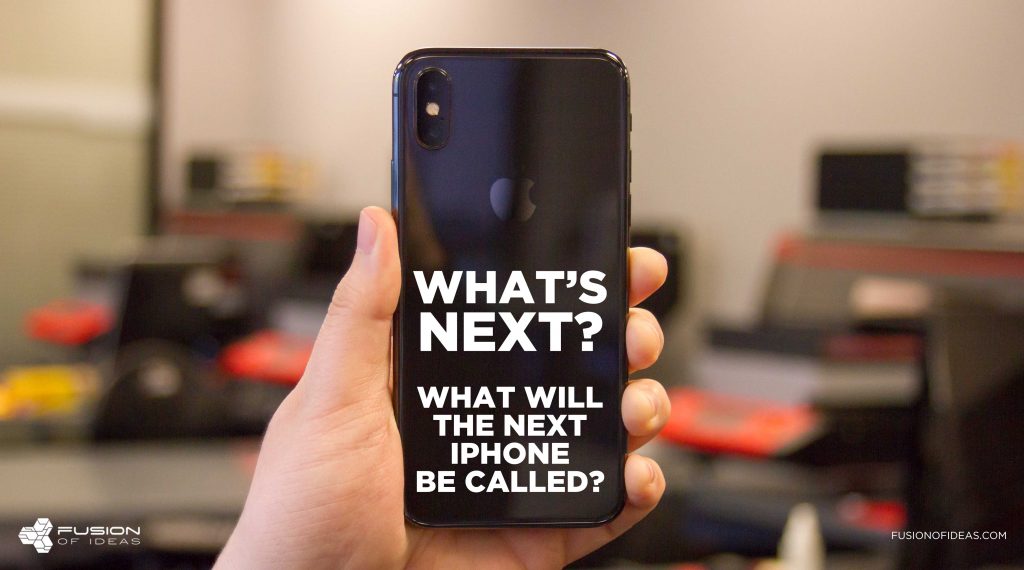 There’s been a lot of speculation as to what the next iPhone will be called. It’s no secret that Apple typically chooses consecutive numbers for its iPhone releases. But since the iPhone X deviated from that pattern, the name of the next iPhone is up in the air. Will it be called be called iPhone 11? Or iPhone X1? There’s even talk of the lower-end iPhone being called iPhone SE. Rumors have been surfacing that the next generation iPhone might be getting a new name.
There’s been a lot of speculation as to what the next iPhone will be called. It’s no secret that Apple typically chooses consecutive numbers for its iPhone releases. But since the iPhone X deviated from that pattern, the name of the next iPhone is up in the air. Will it be called be called iPhone 11? Or iPhone X1? There’s even talk of the lower-end iPhone being called iPhone SE. Rumors have been surfacing that the next generation iPhone might be getting a new name.
We asked our Fusion of Ideas team for their best guesses on what the new iPhone will be called. The name that got the most votes was iPhone XI. Additional suggestions and name ideas included iPhone Xs, iPhone X-1, iPhone 9, iPhone Elite, iConnect, and iPhone Pro.
“The X isn’t technically the 10, but just a roman numeral to represent the anniversary of the iPhone,” said our Creative Manager, Bryan Underwood. “That being said, I believe the next release in line is still the iPhone 9.”
Rachel Trotter, Administrative Assistant, thinks it’ll be named something completely different. “I don’t even think it will be called an iPhone anymore,” she said. “I think it might be something like iConnect or iLink. Something that implies an iPhone is far more than a phone, but also of a way to interact with the world.”
Junior iOS developer Long Le said, “I think they could keep it boring and just call it the iPhone Xs.”
Whatever it’s called, we’re excited for the debut of the new iPhone and all of its new features.
What We Think of The New HomePod
Since the release of the new Apple HomePod our Fusion of Ideas tech expert and Business Development Manager, Jacob Sarabia, has been busy testing and utilizing the device since the moment we got it. Here is what he’s saying about it:
What do you like and dislike about the design?
Apple has done it again: blending art and technology to create the new HomePod. I personally appreciate the attention to detail on how seamless the fabric mesh covers the internal components. Every detail down to the power cable, which is carefully woven together, showcases the quality of Apple products. Additionally, there are no physical buttons that might distract you from the overall design. Apple accomplished this by placing a touch screen display at the top of the speaker. I had a hard time trying to find things I did not like about the HomePod design. When comparing it to the other speakers on the market, I still chose the HomePod.
We hear that you have to keep the cable installed into the HomePod. Have you found this to be a problem?
Initially, I did question Apple’s decision to make the power cable non-removable when comparing it to other speakers on the market. Technically speaking, it can be removed with some force, which I do not recommend trying (this leads me to believe it’s reserved for servicing the device). If the HomePod is being used the way Apple intended it to be used, then there really is no reason for the cabled to be removed, so overall, this has not been an issue for me.
What’s the audio quality like? How does the HomePod compare to similar smart speakers?
Music has always been in Apple’s DNA, and they certainly proved this with the HomePod. They have upset the marketplace by offering an unparalleled audio listening experience that is like no other competing smart speaker. The audio notes are rich and clear with little to no distortion, even at a 100% volume level. Most of the other speakers on the market focus on AI technology first and speaker quality second.
Is it easy to use Siri on HomePod? Have you encountered any issues?
Siri is just as easy to use on the HomePod as on my current iOS devices. Of course, there are some limitations, but knowing that Siri is available practically everywhere in my home/office is great. One of the down sides to utilizing Siri on the HomePod is that it can’t distinguish my voice from someone else’s. If I allow full access through the initial set up process, anyone can ask Siri to read back my text messages, notifications, and so on. Also, I can’t set up multiple timers, which would be useful while listening to music and cooking. I really see the HomePod being used primarily for music and home automation tasks.
How would the HomePod be used in a business?
For now, the HomePod would be perfect inside of a conference room for taking calls – you can’t beat the amazing sound quality it provides. As Siri progresses, I can imagine a day when developers can integrate Siri into their web/mobile applications to run tasks or provide real-time information by simply asking a question. The HomePod would be the perfect gift for someone who is looking for not just a “smart speaker,” but also better sound quality at a reasonable price point. And it could be a great gift for employees or clients.
Are the HomePods customizable? What areas can be customized?
You know us – at Fusion of Ideas, we always push the limits to provide the best customized out-of-box experience. Every new product release poses new challenges for our team. Different shapes, sizes, and raw materials can all affect our capabilities. The services we currently offer for the HomePod include: custom packaging, laser etching, and our customizable film, Stealth Armor. Stay tuned for more exciting HomePod capabilities as we continue to go through the research and development process.
